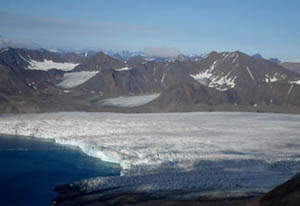Introduction

The archipelago of Svalbard , with a total surface area of 62,000 km2, contains a broad geological diversity. Although 60% of the surface area is covered by glaciers (Picture 1), exceptional outcrop in the remaining areas has enabled geological relationships to be well understood. These include well-preserved sedimentary sequences which are rare or non-existent in other areas of Europe. Spitsbergen is by far the largest island within Svalbard and its mineral resources have provided much of the impetus for industrial development of the archipelago in the 20th Century. Exploitation of impressive coal reserves remains today the cornerstone of the local economy, while oil exploration has, for more than 50 years, been an important activity in and around Svalbard.
Less well known, perhaps, is that Svalbard also hosts a wide variety of metallic and non-metallic mineral deposits. These deposits have attracted the attention of geologists and exploration companies for a century or more, but despite the attention given to them, economic potential has turned out to be rather minor - at least so far.
The mine adit was made 1927 - 1930 by the coal mining company Bjørnøen A/S, and 305.5 tonnes of pure lead sulfide (galena) ore was shipped from this mine. Photo: Tom V. Segalstad, 4 July 2000.
A first period of exploration in the early part of the 20th Century resulted in the limited exploitation of several deposits, chiefly for lead ore (Picture 2). More recently, the potential for economic mineral deposits has been reinvestigated, resulting in new deposits being defined. Perhaps the best known is the Svansen gold deposit for which Store Norsk Kullkompani have sought, unsuccessfully, a license to conduct further exploration including drilling.
Tom V. Segalstad and Nigel Cook (NHM) have been researching several deposits on Svalbard to learn more about their mineralogy and how - and when they were formed. Our partners include Torfinn Kjærnet, formerly Bergmesteren på Svalbard, and Professor Krister Sundblad, Turku University, Finland. Many of the mineral deposits on Svalbard are poorly characterised and there have been few modern studies if any on them. The work, which is ongoing, therefore carries the potential for exciting new discoveries.
More on the research on mineral Resources on Svalbard (Cook, Segalstad)